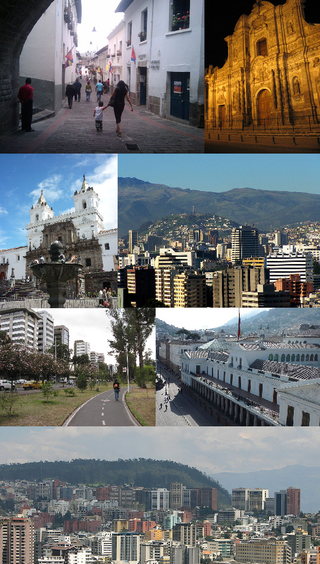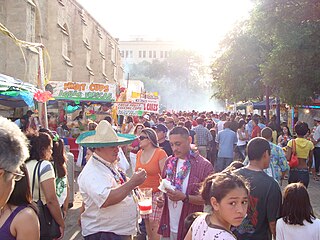Related Research Articles

Carnival is a festive season that occurs during the Christian liturgical period of Shrovetide, the three days before Lent. consisting of Quinquagesima or Shrove Sunday, Shrove Monday, and Shrove Tuesday or Mardi Gras.

Columbus Day is a national holiday in many countries of the Americas and elsewhere, and a federal holiday in the United States, which officially celebrates the anniversary of Christopher Columbus's arrival in the Americas. Columbus went ashore at Guanahaní, an island in the Bahamas, on October 12, 1492. On his return in 1493, Columbus moved his coastal base of operations 70 miles east to the island of Hispaniola, what is now the Dominican Republic and established the settlement of La Isabela, the first permanent Spanish settlement in the Americas.

Quito, officially San Francisco de Quito, is the capital of Ecuador, with an estimated population of 2.8 million in its metropolitan area. It is also the capital of the province of Pichincha. Quito is located in a valley on the eastern slopes of Pichincha, an active stratovolcano in the Andes.

The festival of San Fermín is a week-long, historically rooted celebration held annually in the city of Pamplona, Navarre, Spain. The celebrations start at noon on 6 July and continue until midnight on 14 July. A firework (Chupinazo) starts off the celebrations and the popular song Pobre de mí is sung at the end. The most famous event is the running of the bulls, which begins at 8 a.m. each day on 7–14 July, but the festival involves many other traditional and folkloric events. It is known locally as Sanfermines in Spanish and Sanferminak in Basque, and is held in honour of Saint Fermin, the co-patron of Navarre.

In the Gregorian calendar, New Year's Eve, also known as Old Year's Day, is the evening or the entire day of the last day of the year, 31 December. In many countries, New Year's Eve is celebrated with dancing, eating, drinking, and watching or lighting fireworks. Some Christians attend a watchnight service. The celebrations generally go on past midnight into New Year's Day, 1 January.

A quinceañera is a celebration of a girl's 15th birthday that is common in Mexican and other Latin American cultures. The girl celebrating her 15th birthday is a quinceañera. In Latin America, the term quinceañera is reserved solely for the honoree; in English, primarily in the United States, the term is used to refer to the celebrations and honors surrounding the special occasion.

The National Day of Spain is a national holiday held annually on 12 October. It is also traditionally and commonly referred to as the Día de la Hispanidad, commemorating Spanish legacy worldwide, especially in Hispanic America.

Latacunga is a plateau city of Ecuador, capital of the Cotopaxi Province, 89 km (55 mi) south of Quito, near the confluence of the Alaquez and Cutuchi rivers to form the Patate, the headstream of the Pastaza. At the time of census 2022 Latacunga had a population of 77,267 largely mestizo and indigenous.

Nochistlán is a city in the Mexican state of Zacatecas. Nuño Beltrán de Guzmán, on December 3, 1531, hired Cristóbal de Oñate to establish a village in Nochistlán; the village would be named Guadalajara to honor Guzmán for having been born in Guadalajara. Guadalajara was founded in Nochistlán on January 5, 1532. Its first officials were Cristóbal de Oñate, Sancho Ortiz de Zúñiga, Juan de Albornoz and Miguel de Ibarra. They worked at this project for only 16 months and created the first layout of Guadalajara.

Sincelejo is the capital and largest city of the Colombian department of Sucre in the Caribbean region. It is also the capital of the department's subregion, Sabanas, and is the 25th largest city by population of the country. It is located 30 kilometers from the Caribbean Sea at the Gulf of Morrosquillo, 125 kilometers from Cartagena, and 200 kilometers from Barranquilla.

Juigalpa is the municipal seat of Juigalpa Municipality and the capital city of the Chontales Department of Nicaragua. It is located within the municipality of Juigalpa, approximately 140 km east of Managua on Carretera Rama, in the central region of Nicaragua.

Fiestas de Santa Fe is a festival held every autumn in Santa Fe, New Mexico, usually during the second week of September.

The carnival in Colombia was introduced by the Spaniards. The Colombian carnival has incorporated elements from European culture, and has managed to syncretise, or re-interpret, traditions that belonged to the African and Amerindian cultures of Colombia. There is documentary evidence that the carnival existed in Colombia in the 17th century and had already caused concern to the colonial authorities, who censored the celebrations, especially in the main centers of power such as Cartagena, Bogotá and Popayán. The carnival, therefore, continued its evolution and re-interpretation in the small and at that time unimportant towns where celebrations did not offend the ruling elites. The result was the uninterrupted celebration of carnival festivals in Barranquilla, and other villages along the lower Magdalena River in northern Colombia, and in Pasto, Nariño in the south of the country. In modern times, there have been attempts to introduce the carnival in the capital, Bogotá, in the early 20th century, but it has always failed to gain the approval of authorities. The Bogotá Carnival has had to wait until the 21st century to be resurrected, this time, by the authorities of the city. Colombia is recognized by its large variety of festivals, carnivals and fairs. Most towns have their own, ranging from those celebrating coffee to the ones held in honor of the town's Saint feast. The common characteristics of the festivals are the nomination of a beauty Queen and the setting up of public dance floor.
Villamañán is a town located in the south-west of the province of León, Spain, in the area known as Esla, in the autonomous community of Castile and León in Spain.

Fiesta San Antonio is an annual festival held in April in San Antonio, Texas, and is the city's signature event since 1891. The festival, also known as the Battle of Flowers, commemorates of the Battle of the Alamo, which took place in San Antonio, and the Battle of San Jacinto, which led to Texas' independence from Mexico in April 1836.
Carnival in Mexico is celebrated by about 225 communities in various ways, with the largest and best known modern celebrations occurring in Mazatlán and the city of Veracruz.
Las Mañanitas is an annual event held in Ponce, Puerto Rico, dedicated to Our Lady of Guadalupe. It consists of a pre-dawn popular parade, followed by a Catholic Mass, and a popular town breakfast hosted by the municipal government. It takes place on 12 December, and is a traditional event sponsored by the Roman Catholic Diocese of Ponce but attended by Catholic leaders from Puerto Rico at large. Widely covered by the press every year, the event is attended by over 10,000 people, including religious and political leaders and the general public. Due to the coronavirus pandemic, the 2020 celebration will take place in a modified program fashion: there will be no walked procession, as traditionally done, but instead the Eucharist will be televised and would-be attendees can instead celebrate Las Mañanitas from their own homes.
The Magdalena Festival is the main festivity of Castellón de la Plana, the capital city of the province of Castelló, in the Valencian Community, Spain. It commemorates the origins of the city, recalling the move of the city from the Hill of Mary Magdalene to the fertile coastal plain in 1251.

Fiestas patronales de Ponce is an annual cultural celebration held at Plaza Las Delicias in Ponce, Puerto Rico. The celebration, which commonly lasts three days, takes place in late December. Ponce's Fiestas patronales are heavily influenced by Spanish culture and religion, and are a tradition held in honor of the city's patron saint, the Virgen of Guadalupe. As such the celebration may be as old as the town itself (1692). The festivities usually include religious processions honoring its Catholic heritage. However, elements of African and local culture have been incorporated as well. They also feature parades, games, artisans, amusement rides, regional food, and live entertainment. It is attended mostly by people from the city of Ponce and its 18 surrounding barrios, but also people from all over Puerto Rico. The free event's attendance is estimated in the hundreds every day.
References
- ↑ Moeller, Nathalie (28 November 2017). "Fiestas de Quito! The Capital City's Favorite Celebration". Metropolitan Touring. Retrieved 12 December 2022.
- 1 2 "Ecuador: "Fiestas de Quito": Tradition and Resistance". Global Voices. 10 December 2010. Archived from the original on 4 August 2020. Retrieved 12 December 2022.